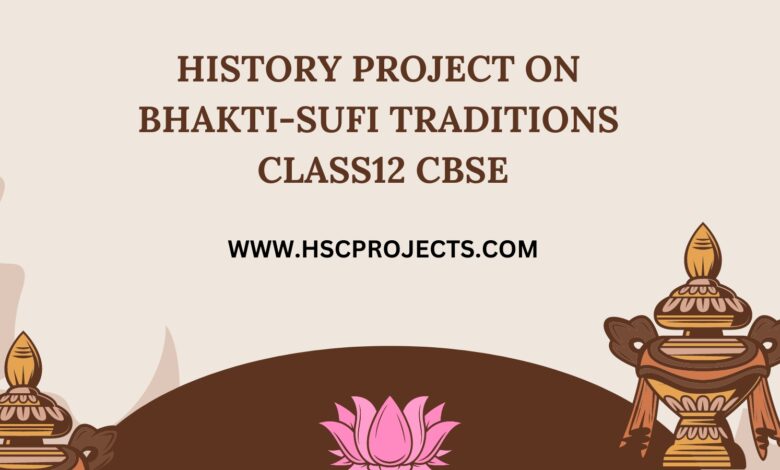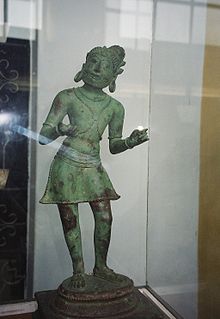
History Project On Bhakti-Sufi Traditions Class12 CBSE
A BRIEF HISTORY OF TRADITION
The term “Bhakti-Sufi tradition” refers to a religious movement that originated in mediaeval India and placed an emphasis on mystical experience (Sufi) and devotion (bhakti) as ways to find salvation. The rigidity and hierarchy of the caste system and the institutionalised structure of religion gave rise to the tradition.
Another syncretic tradition that resulted from the interplay of Hinduism and Islam in India is the Bhakti-Sufi tradition. The tradition combined features from both religions, and its proponents frequently tried to make peace with the conflicts between the two.
The advent of various saint-poets who wrote devotional poetry in popular vernacular languages during the Bhakti-Sufi movement was notable. Through their poetry and music, they aimed to spread their message of love, acceptance, and brotherhood.
The Bhakti-Sufi tradition was widespread throughout India and was not confined to any one area or group of people. The movement had a significant impact on Indian society, and it continues to have an impact on India today.

THE INTEGRATION OF CULTS
Many cults and religious practises were incorporated into the Bhakti-Sufi tradition. The tradition included aspects of Islam, Shaivism, Vaishnavism, and other Hindu sects.
Syncretic religious practises came into existence as a result of cult integration. For example, devotees of the Bhakti-Sufi tradition frequently revere both Hindu and Islamic saints. It was referred to as “bhakti-sufi syncretism” this kind of devotion.
New genres of poetry and music also developed as a result of cult absorption. The Bhakti-Sufi saint-poets created devotional poetry and music influenced by both Hindu and Islamic traditions. As a result, a brand-new genre of music called “qawwali,” which is still well-liked in Pakistan and India, emerged.
Cult integration has a big effects on social and cultural norms as well. The equality, brotherhood, and social justice ideals preached by the Bhakti-Sufi tradition posed a threat to the established social order. New social and cultural norms emerged as a result, including the encouragement of vegetarianism, the rejection of caste systems, and the appreciation of variety.
CONFLICT AND DIFFERENCE
While love, tolerance, and brotherhood were stressed in the Bhakti-Sufi tradition, there were also instances of disagreement and strife within the movement.
Whether to reject or accept Islamic customs was one of the key points of contention within the Bhakti-Sufi tradition. Some supporters of the tradition accepted Islamic practises while others outright rejected them. This caused conflict among the movement’s adherents, with some supporting a more syncretic style of worship and others believing in upholding the purity of their individual religious traditions.
The Bhakti-Sufi tradition also saw instances of strife between various groups. For instance, the rivalry within the Bhakti tradition between the Nirguna and Saguna groups is widely known. While the Saguna sect revered a god with form and traits, the Nirguna sect worshipped an abstract, formless deity. Conflicts and tensions between the two factions resulted from this.
Moreover, the orthodox components of Islam and Hinduism opposed the Bhakti-Sufi tradition. The movement was challenged by the orthodox forces who considered the Bhakti-Sufi heritage as a danger to their different religious traditions. As a result, there were cases of violence and persecution directed at Bhakti-Sufi adherents.
The Bhakti-Sufi tradition persisted as a potent force for social and cultural change in mediaeval India despite these discrepancies and conflicts.
BHAKTI MOVEMENT

The Bhakti-Sufi tradition included the Bhakti movement as a key element. The movement began in South India in the seventh century CE, and over the following several centuries, it spread to other regions of India.
The Bhakti movement placed a strong emphasis on devotion (bhakti) as a way to find salvation. The movement opposed the institutionalised structure of religion as well as the rigidities of the caste system. The Bhakti saints wrote devotional poetry in popular vernacular languages that the general public could understand. Through their poetry and music, they aimed to spread their message of love, acceptance, and brotherhood.
Indian society was significantly impacted by the Bhakti movement. The movement pushed for equality and brotherhood while criticising the current socioeconomic structure. The lower castes and other marginalised groups in society responded well to the Bhakti saints’ calls for an end to caste hierarchies.
Additionally, the Bhakti movement had a significant influence on Indian literature and music. The movement also saw the creation of new genres of music and dance, such as the devotional music known as “kirtan,” which was inspired by the devotional poetry written by the Bhakti saints.
Long after it had reached its peak, the Bhakti movement nevertheless had an impact on Indian society and culture. People in modern India are still motivated by the movement’s goals and ideals.
WOMEN IN THE BHAKTI MOVEMENT

In the Bhakti movement, women were very important. The movement gave women a forum to voice their opinions and ideas, which was not feasible in mediaeval India’s male-dominated culture.
During this time, a number of female Bhakti saints rose to prominence, writing devotional poetry and aiding in the movement’s growth. The well-known female Bhakti saints are Janabai, Mirabai, Andal, Akka Mahadevi, and Lal Ded.
Women have an alternative to the customary role of women in society because to the Bhakti movement. The movement emphasised the superiority of devotion and spiritual experience above gender and contested the idea that women were less valuable than males.
Additionally, the Bhakti movement emphasised the concepts of equality and fraternity, which aided in the dismantling of caste and gender barriers. The Bhakti saints spoke out against gender inequality and fought for women’s rights.
With women taking a large role in these professions, the Bhakti movement also had a huge impact on Indian literature and music. Women also contributed significantly to the creation of new genres of music and dance, including the devotional music known as “bhajan” and the dance form known as “Bharatanatyam,” both of which were inspired by the devotional poetry written by female Bhakti saints.
In general, the Bhakti movement gave women a voice and a platform to question conventional gender roles in Indian society.
DEVOTE FEMALES
In the Bhakti-Sufi tradition, women devotees were especially important in the devotion of saints and pilgrimage destinations. Women made up a sizable number of the Bhakti-Sufi saints’ devotees, and their devotion was essential in spreading the movement throughout the nation.
Women devotees would sing and dance in the presence of other devotees, fostering a cheerful and celebratory atmosphere, during the performance of devotional music and dance, known as “satsang” or “kirtan.” This was a change from how women were typically expected to behave in society, which was to be silent and obedient.
The transmission and preservation of the Bhakti-Sufi saints’ teachings were greatly aided by female devotees. They would commit the saints’ lessons to memory and transmit them orally to succeeding generations.
In contrast to the male-dominated society of mediaeval India, the Bhakti-Sufi tradition allowed women to express their devotion and spirituality. Caste and gender boundaries could be broken down by female devotees engaging with the saints and engaging in religious rituals on an equal level with male followers.
In conclusion, women devotees played a significant part in the development and dissemination of the love, tolerance, and brotherhood message of the Bhakti-Sufi tradition throughout the nation.
THE JAMIL SAINTS ALVARS
The 12 Tamil Vaishnava poets known as the Alvars are regarded as the founders of the Bhakti movement in South India. They lived between the sixth and ninth centuries CE. Another name for them is the Jamil saints, which is Arabic for “those immersed in God.”
Tamil devotional poetry was written by the Alvars to show their fervent devotion to Lord Vishnu. One of the earliest and most important contributions to Indian Bhakti literature is thought to be their poetry.
The poetry of the Alvars frequently took the form of songs or hymns that were chanted at temples and other places of worship. The Alvars are regarded as the founders of the Bhakti movement in South India and their songs had a significant influence on the worship of Vishnu in that region.
The Alvars’ teachings placed a strong emphasis on the necessity of devotion and total surrender to God in order to find salvation. They disapproved of the rigid Brahmanical beliefs that predominated Indian society at the time, including the caste system. The Alvars’ teachings were crucial in advancing social justice and equality, and people in modern-day India are still motivated by them.
The Alvars’ influence spanned the entirety of India; Bhakti saints all over the country were influenced by their teachings and poetry. Their influence may be observed in the writings of other Bhakti saints like Chaitanya Mahaprabhu, Madhva, and Ramanuja.
In conclusion, the Tamil Vaishnava poets known as the Alvars, often referred to as the Jamil saints, were instrumental in the growth of the Bhakti movement in South India. People in modern India are still motivated by their spiritual poetry and teachings.
TAMIL NADU’S NAYANARS

The Nayanars were a group of 63 Tamil Shaivite saints who were instrumental in South India’s Bhakti movement and lived during the sixth and eighth century CE. They wrote Tamil poetry that reflected their love and devotion for Lord Shiva.
In order to find salvation, the Nayanars’ teachings stressed the significance of dedication, love, and surrender to Lord Shiva. They disapproved of the rigid Brahmanical beliefs that predominated Indian society at the time, including the caste system. The teachings of the Nayanars were crucial in advancing social justice and equality, and they still inspire people in modern-day India.
In temples and other religious gatherings, hymns and songs were frequently used to convey the poetry and teachings of the Nayanars. They are regarded as the forerunners of the Shaivite Bhakti movement in South India and their poetry had a significant influence on the worship of Shiva in that region.
Other Bhakti saints all around India were influenced by the Nayanars’ teachings and poetry, showing how far-reaching their influence was. Other Bhakti saints’ writings, including those of Basavanna, who established the Lingayat sect in Karnataka, reflect their influence.
In conclusion, the 63 Tamil Shaivite saints known as the Nayanars were crucial in the growth of the Bhakti movement in South India. In modern India, people are still inspired by their devotional poetry and teachings, and other Bhakti saints all around the nation have been influenced by them.
THE KARNATAKA VIRASHAIVA TRADITION
The Shaivite Bhakti movement that started in Karnataka in the 12th century CE is known as the Virashaiva tradition. Basavanna, a social reformer and philosopher, founded it in an effort to overthrow the Brahmanical social structure and advance social equality and justice.
Basavanna opposed the established caste structure and placed a strong emphasis on the value of individual dedication and morality. He pushed for the establishment of an egalitarian society in which every person, regardless of caste or social standing, would have access to education, religious ceremonies, and social opportunities.
The Virashaiva tradition is distinguished by its emphasis on Lord Shiva devotion and opposition to idolatry. The tradition’s adherents partake in community service and social welfare endeavours as well as devotional rituals like dancing and singing in Shiva’s honour.
The Virashaiva tradition has had a considerable influence on Kannada literature, art, and culture. Many Kannada writers and artists have drawn inspiration from the tradition’s poetry and philosophy, and the state’s thriving folk traditions are also affected.
Beyond Karnataka, the Virashaiva tradition has a national impact thanks to the inspiration provided by its teachings and philosophy for social and religious reform movements. People in modern-day India still find the tradition’s emphasis on social equality and individual devotion to be meaningful.
In conclusion, the Shaivite Bhakti movement known as the Virashaiva tradition began in Karnataka in the 12th century CE. It was started by the social reformer and philosopher Basavanna and focused on the value of personal dedication and societal equality. The tradition has had a great influence on Kannada literature, art, and culture, and its lessons are still motivating people in modern India.
DEVELOPMENT OF ISLAMIC CUSTOMS
When Arab traders first arrived on the Indian subcontinent in the eighth century CE, Islamic traditions began to evolve in India. Islamic influence grew over time, and the faith started to spread both peacefully and violently.
Sufism, a mystical style that highlighted the inward, spiritual components of Islam, was one of the important Islamic faiths to arise in India. Dervishes or Sufi saints spread their message of love, devotion, and altruism while travelling throughout India. They emphasised the value of having a personal encounter with God through prayer, music, and other forms of devotion.
In particular among the people, Sufi saints were vital to the propagation of Islam in India. They delivered a message of love and tolerance that touched individuals from all different social and religious backgrounds. Sufism was approachable by people from all backgrounds, regardless of their social or economic level, because to its emphasis on individual spiritual experience.
The Deccan Sultanate, a Muslim dynasty that ruled over some of southern India during the 14th and 17th centuries CE, was another prominent Islamic legacy to arise in India. The sultans supported literature, music, and other arts, and their courts served as hubs for learning and knowledge. India today still bears the artistic, architectural, and literary traces of the Deccan Sultanate.
In conclusion, the 8th century CE marks the beginning of Islamic traditions in India. The growth of Islam in India was greatly aided by Sufism, a mystic school that placed an emphasis on the inner, spiritual aspects of Islam. Another significant Islamic culture to arise in India was the Deccan Sultanate, whose effects on literature, art, and architecture may still be felt today.
THE EXPANSION OF SUFISM
The rise of Islam in India is directly related to the development of Sufism in that nation. Dervishes or saints of the Sufi school were instrumental in popularising Islam, especially among the masses.
Its focus on love and devotion was one factor in Sufism’s success in India. People from various backgrounds were moved by the love and tolerance that the Sufi saints preached. They emphasised the value of one’s own direct encounter with God and personal spiritual experience, which opened up Sufism to people of various social and religious backgrounds.
Indian culture and philosophy were incorporated into the teachings of the Sufi saints in an effort to conform to local customs and traditions. With the aid of this strategy, they were able to establish deeper connections with others and win their trust and respect.
Sufism’s emphasis on music and dance was also a major factor in India’s adoption of the religion. People from various religions and socioeconomic classes gathered to watch Sufi artists play, and their music, especially qawwali, became a well-liked form of religious expression.
Sufism developed into a number of distinct orders, or silsilas, over time, each with their own practises and doctrines. The Chishti, Qadiri, and Suhrawardi orders are some of the most important Sufi orders in India.
Sufism’s ascent in India had a significant impact on Indian society and culture. It spread a message of love, tolerance, and compassion and assisted in bridging the gap between various religious and societal groups. Especially in the lively music and poetry traditions of India today, Sufism’s impact may still be seen.
In conclusion, the spread of Islam in India was intimately associated with the development of Sufism. Sufi saints were essential in the spread of Islam, especially among the common people. Sufism’s acceptance of regional customs and traditions, focus on love and devotion, and use of song and dance all led to its appeal in India. Sufism’s rise has a significant influence on Indian society and culture, spreading a message of compassion, tolerance, and love.
THE INDIAN SUBCONTINENT’S CHISHTI PEOPLE
One of the most significant Sufi organisations in India, the Chishti order has a long history that stretches back to the 12th century CE. Khwaja Moinuddin Chishti, a Sufi saint who lived in Ajmer, Rajasthan, brought the Chishti order from Afghanistan to India.
In its teachings, the Chishti order emphasised the interconnectedness of all religions and the significance of love and dedication in spiritual practise. The order’s interpretation of Sufism placed a strong emphasis on the virtues of humility, selflessness, and service to others.
The Chishti order rose to prominence in India quite fast, and it had a significant impact in the north of the country. The Chishti order attracted notable individuals from many walks of life who were drawn to its teachings, including kings, academics, and poets.
The Chishti order’s emphasis on the use of poetry and music in spiritual practise is one of its distinctive features. The Chishti saints held that one might communicate with God and share spiritual insights and experiences through music and poetry.
The flourishing music and poetry traditions of modern-day India are notably evidence of the Chishti order’s continuing impact. Particularly connected to the Chishti order is the Sufi devotional music genre known as the qawwali, whose influence may be heard in the compositions of well-known qawwali artists like Nusrat Fateh Ali Khan.
In conclusion, the Chishti order, which has a long history that stretches back to the 12th century CE, is one of the most significant Sufi groups in India. The order’s teachings placed a strong emphasis on love, dedication, and service to others, and you can still hear the order’s impact in the lively music and poetry traditions of India. The Sufi method of the Chishti order, especially its use of poetry and song, is still a prominent element of India’s cultural history.
CONCEPT OF KHANQAH
One of the major tenets of Sufism, especially on the Indian subcontinent, is the Khanqah concept. Sufi disciples congregate in a Khanqah to learn the teachings of their Shaykh and practise spiritual disciplines including dhikr (remembering God) and meditation.
Khanqahs, which served as hubs for spiritual study and practise, were essential to the expansion of Sufism in India. Sufi gurus, or shaykhs, would set up Khanqahs throughout the nation, and students would come from all around to learn under them.
The Khanqah system’s emphasis on a personal contact between the Sufi teacher and his pupils is one of its distinctive features. The shaykh is regarded as a spiritual mentor and teacher, and followers are required to submit completely to their master’s instructions and leadership.
Additionally, the Khanqah system was essential in advancing interreligious cooperation. Sufi masters preached a message of love and tolerance, which helped to bridge the gap between many cultures. Khanqahs were frequently open to individuals of all religions and socioeconomic classes.
The Khanqah system developed over time into various distinct orders, or silsilas, each with its own practises and doctrines. Among the most important Sufi orders in India are the Chishti, Qadiri, and Suhrawardi orders, each of which has its own network of Khanqahs.
In conclusion, the idea of Khanqah is crucial to Sufism, especially in the Indian subcontinent. Khanqahs served as places of spiritual instruction and practise, drawing students from all over the world to study with Sufi gurus. The Khanqah system encouraged social and religious peace and emphasised the value of a close bond between the master and his pupils. The Khanqah system is still a crucial component of Sufi culture and practise in India today.
IDEA OF THE SILSILA
An essential component of Sufism, especially in the Indian subcontinent, is the idea of Silsila. A Silsila is a spiritual line of descent that connects a Shaykh or Sufi master to those who came before him, all the way back to the Prophet Muhammad (peace be upon him).
The shaykh is regarded in the Silsila system as the transmitter of the spiritual lineage and teachings of his forebears, and his pupils are supposed to adhere to his direction and teachings. The Silsila system places a strong emphasis on the necessity of continuing the Prophet Muhammad’s (peace be upon him) line of spiritual transmission in its entirety.
As Sufi masters established their orders or Silsila and passed on their teachings to their pupils, who in turn became shaykhs and established their orders, the Silsila system played a critical part in the growth of Sufism in India.
Among the most important Sufi groups in India are the Chishti, Qadiri, and Suhrawardi orders. Each of these orders has a Silsila that traces its origins to the Prophet Muhammad (peace be upon him). The Silsila method has aided in conserving the teachings and practises of the Sufi masters and passing them on to subsequent generations, fostering a feeling of continuity and tradition in Sufi practise.
The Silsila system’s emphasis on the shaykh’s and his pupils’ spiritual bond is one of its distinctive features. The shaykh serves as a spiritual mentor and adviser to his followers, and the Silsila system emphasises the value of this direct contact.
In conclusion, the idea of Silsila is fundamental to Sufism, especially in the Indian subcontinent. A Sufi teacher or Shaykh is connected to his ancestors through a spiritual chain of transmission known as the Silsila system.
FRESH RELIGIOUS ROUTES IN NORTHERN INDIA
During the Middle Ages, especially in the 14th and 15th centuries, new spiritual routes arose in northern India. These religious approaches, which emphasised the value of devotion and love for God, were frequently linked to certain poets and saints.
The Nirguna Bhakti movement, which emphasised devotion to a formless and attributeless God rather than worshipping a God with qualities, was one of the most important new devotional pathways. Along with other poet-saints, the Nirguna Bhakti movement was linked to Ravidas, Nanak, and Kabir.
The Saguna Bhakti movement, which emphasised the worship of God with form and qualities, was another prominent devotional approach. The poet-saints Surdas, Tulsidas, and Mirabai were some of the poet-saints connected to the Saguna Bhakti movement.
The democratisation of religious practise that these new devotional routes exhibited was due to their emphasis on the value of personal devotion to and love for God, regardless of social standing or caste. Additionally, they were linked to the usage of regional languages like Hindi rather than the formal Sanskrit found in older Hindu religious literature.
The region’s religious and cultural landscape was significantly impacted by the new devotional routes that emerged in northern India, and those effects can still be felt today. The growth of Sikhism, which originated in the 16th century and included many aspects of the Nirguna Bhakti tradition, was significantly influenced by the Nirguna Bhakti movement in particular.
In conclusion, new devotional paths that emphasised the value of devotion and love for God evolved in northern India during the mediaeval era. These religious routes were characterised by a democratisation of religious practise and the use of local languages, and they were linked to specific poets and saints. Two of the most important new devotional approaches were the Nirguna Bhakti and Saguna Bhakti movements, and the effects of their influence may still be felt in the region’s religious and cultural customs today.
CONCLUSION
As a whole, India’s Bhakti-Sufi traditions constitute a rich and varied cultural and religious heritage that has significantly influenced Indian society and culture. These traditions have been distinguished by a strong focus on devotion, love, and submission to the divine, as well as a rejection of formality and ritualism.
The Bhakti-Sufi traditions have been characterised throughout history by the blending of many cults and the birth of new devotional paths. These advancements have frequently been linked to specific poets and saints who have made a substantial contribution to the development of India’s religious and cultural milieu.
Conflicts and divergences have also been a part of the Bhakti-Sufi traditions, particularly between the Muslim and Hindu populations. Nevertheless, despite these variations, the Bhakti-Sufi traditions have remained a significant component of India’s cultural and religious legacy and they continue to have an impact on the nation’s cultural and religious practises today.
The Bhakti-Sufi traditions are an overall strong and dynamic cultural and religious legacy that continues to inspire and enhance the lives of millions of people in India and around the world.
CERTIFICATE
This is to certify that I, [Your Name], a student of Class 12 at [Your School Name], have successfully completed my History Project on the topic “Bhakti-Sufi Traditions in Medieval India. “
Throughout this project, I embarked on a fascinating journey into the religious movement that originated in medieval India, emphasizing mystical experience (Sufi) and devotion (bhakti) as paths to salvation. Exploring the rich history of the Bhakti-Sufi tradition, I uncovered its profound impact on Indian society and culture.
I delved into the syncretic nature of this tradition, which beautifully blended elements from Hinduism and Islam, bridging the gaps between these two religions. I was amazed to learn how the Bhakti-Sufi saint-poets used their devotional poetry and music to spread messages of love, acceptance, and brotherhood, touching the hearts of people from all walks of life.
Understanding the integration of various cults and religious practices was a captivating aspect of my research. Witnessing how the Bhakti-Sufi tradition absorbed aspects of Islam, Shaivism, Vaishnavism, and other Hindu sects showcased the inclusivity and acceptance that defined this movement.
The conflicts and differences within the Bhakti-Sufi tradition intrigued me deeply. The debates surrounding the acceptance or rejection of Islamic customs and the rivalries between the Nirguna and Saguna groups added layers of complexity to this vibrant religious tapestry.
Another inspiring aspect of my research was discovering the significant role of women in the Bhakti movement. Female Bhakti saints like Janabai, Mirabai, Andal, Akka Mahadevi, and Lal Ded challenged societal norms, using their poetry and music to advocate for gender equality and empowerment.
The concept of Khanqah and Silsila fascinated me, as I understood how these spiritual lineages fostered a close bond between the Sufi teachers and their disciples, preserving and passing on their teachings through generations.
This project has been a deeply enriching experience for me, as I not only learned about our cultural and religious heritage but also gained valuable insights into the importance of love, tolerance, and unity in shaping a harmonious society.
I express my heartfelt gratitude to my school and teachers for providing me with the opportunity to delve into this captivating subject. Their guidance and encouragement have been instrumental in the successful completion of this project.
With great pride and satisfaction, I accept this Certificate of Completion for my History Project on “Bhakti-Sufi Traditions in Medieval India. ” I hope that my work will contribute to a better understanding and appreciation of our diverse and profound cultural legacy.
[Your Name]Class 12, [Your School Name]Date: [Date of Completion]In order to download the PDF, You must follow on Youtube. Once done, Click on Submit
Follow On YoutubeSubscribed? Click on Confirm
Download History Project On Bhakti-Sufi Traditions Class12 CBSE PDF






